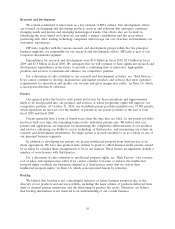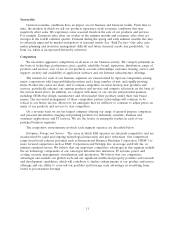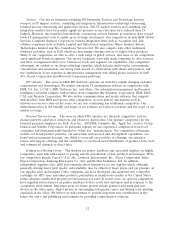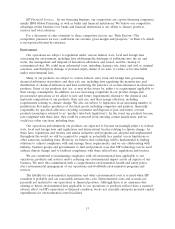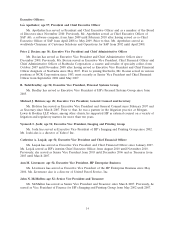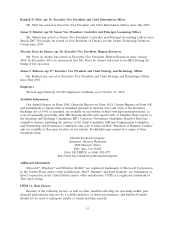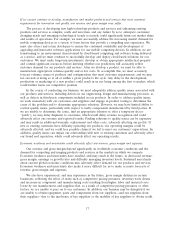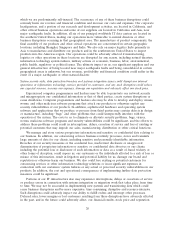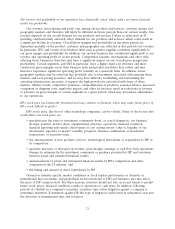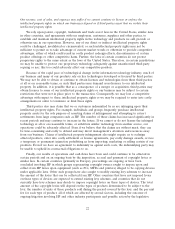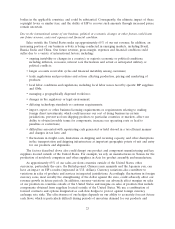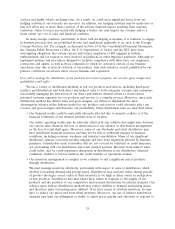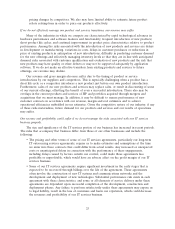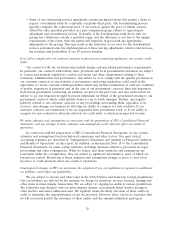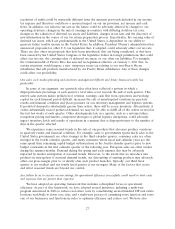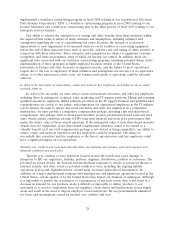HP 2010 Annual Report Download - page 28
Download and view the complete annual report
Please find page 28 of the 2010 HP annual report below. You can navigate through the pages in the report by either clicking on the pages listed below, or by using the keyword search tool below to find specific information within the annual report.which we are predominantly self-insured. The occurrence of any of these business disruptions could
seriously harm our revenue and financial condition and increase our costs and expenses. Our corporate
headquarters, and a portion of our research and development activities, are located in California, and
other critical business operations and some of our suppliers are located in California and Asia, near
major earthquake faults. In addition, all six of our principal worldwide IT data centers are located in
the southern United States, making our operations more vulnerable to natural disasters or other
business disruptions occurring in that geographical area. The manufacture of product components, the
final assembly of our products and other critical operations are concentrated in certain geographic
locations, including Shanghai, Singapore and India. We also rely on major logistics hubs primarily in
Asia to manufacture and distribute our products and in the southwestern United States to import
products into the Americas region. Our operations could be adversely affected if manufacturing,
logistics or other operations in these locations are disrupted for any reason, including natural disasters,
information technology system failures, military actions or economic, business, labor, environmental,
public health, regulatory or political issues. The ultimate impact on us, our significant suppliers and our
general infrastructure of being located near major earthquake faults and being consolidated in certain
geographical areas is unknown, but our revenue, profitability and financial condition could suffer in the
event of a major earthquake or other natural disaster.
System security risks, data protection breaches and systems integration issues could disrupt our internal
operations or information technology services provided to customers, and any such disruption could reduce
our expected revenue, increase our expenses, damage our reputation and adversely affect our stock price.
Experienced computer programmers and hackers may be able to penetrate our network security
and misappropriate our confidential information or that of third parties, create system disruptions or
cause shutdowns. Computer programmers and hackers also may be able to develop and deploy viruses,
worms, and other malicious software programs that attack our products or otherwise exploit any
security vulnerabilities of our products. In addition, sophisticated hardware and operating system
software and applications that we produce or procure from third parties may contain defects in design
or manufacture, including ‘‘bugs’’ and other problems that could unexpectedly interfere with the
operation of the system. The costs to us to eliminate or alleviate security problems, bugs, viruses,
worms, malicious software programs and security vulnerabilities could be significant, and the efforts to
address these problems could result in interruptions, delays, cessation of service and loss of existing or
potential customers that may impede our sales, manufacturing, distribution or other critical functions.
We manage and store various proprietary information and sensitive or confidential data relating to
our business. In addition, our outsourcing services business routinely processes, stores and transmits
large amounts of data for our clients, including sensitive and personally identifiable information.
Breaches of our security measures or the accidental loss, inadvertent disclosure or unapproved
dissemination of proprietary information or sensitive or confidential data about us or our clients,
including the potential loss or disclosure of such information or data as a result of fraud, trickery or
other forms of deception, could expose us, our customers or the individuals affected to a risk of loss or
misuse of this information, result in litigation and potential liability for us, damage our brand and
reputation or otherwise harm our business. We also could lose existing or potential customers for
outsourcing services or other information technology solutions or incur significant expenses in
connection with our customers’ system failures or any actual or perceived security vulnerabilities in our
products. In addition, the cost and operational consequences of implementing further data protection
measures could be significant.
Portions of our IT infrastructure also may experience interruptions, delays or cessations of service
or produce errors in connection with systems integration or migration work that takes place from time
to time. We may not be successful in implementing new systems and transitioning data which could
cause business disruptions and be more expensive, time consuming, disruptive and resource-intensive.
Such disruptions could adversely impact our ability to fulfill orders and interrupt other processes.
Delayed sales, lower margins or lost customers resulting from these disruptions have adversely affected
in the past, and in the future could adversely affect, our financial results, stock price and reputation.
20


